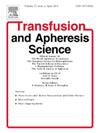Anti-M induced severe Hemolytic Disease of the Fetus and Newborn: The role of the Monocyte Monolayer Assay in elucidating the clinical relevance of alloantibodies in pregnancy
IF 1.2
4区 医学
Q4 HEMATOLOGY
引用次数: 0
Abstract
Introduction
Hemolytic Disease of the Fetus and Newborn (HDFN) is associated with the induction of fetal anemia. Usually, the occurrence of this disease is associated with alloantibodies directed to Rh and K antigens, while severe or fatal cases involving anti-M are rare, especially in non-Asian populations. The Monocyte Monolayer Assay (MMA) is a cellular assay that has been shown to be useful in defining the clinical importance of antibodies.
Case description
Severe fetal anemia induced by anti-M was observed in a pregnant 32-year old white Brazilian woman. The immunohematological investigation revealed the presence of two other alloantibodies in the maternal serum. The use of the MMA contributed to elucidating the case, associating only anti-M with the evidenced outcome.
Discussion
The presence of anti-M in pregnant women is generally not a concern, as it is commonly identified as a benign IgM antibody of natural origin. However, it can also be present in its IgG isoform of immune origin, which is associated with both destruction of fetal red cells and suppression of erythropoiesis. There is still no consensus among professionals for the monitoring of pregnant women through the titration of anti-M. In this context, MMA may be useful to clarify the unfavorable outcomes observed in pregnancies of alloimmunized women.
Conclusion
The present report describes a rare case of severe fetal anemia associated with maternal anti-M in a Brazilian woman and how MMA assisted to elucidate the clinical relevance of the alloantibodies detected.
抗m诱导的胎儿和新生儿严重溶血性疾病:单核细胞单层试验在阐明妊娠同种异体抗体临床相关性中的作用
胎儿和新生儿溶血性疾病(hddn)与胎儿贫血的诱导有关。通常,这种疾病的发生与针对Rh和K抗原的同种抗体有关,而涉及抗m抗体的严重或致命病例很少,特别是在非亚洲人群中。单核细胞单层试验(MMA)是一种细胞试验,已被证明在确定抗体的临床重要性方面是有用的。病例描述:在一名32岁巴西白人孕妇中观察到抗m诱导的严重胎儿贫血。免疫血液学调查显示在母体血清中存在另外两种同种异体抗体。MMA的使用有助于阐明病例,仅将抗m与证实的结果联系起来。孕妇体内是否存在抗m抗体通常不值得关注,因为它通常被认为是一种天然来源的良性IgM抗体。然而,它也可以存在于免疫来源的IgG亚型中,这与胎儿红细胞的破坏和红细胞生成的抑制有关。对于通过抗m抗体的滴定来监测孕妇,专业人士仍未达成共识。在这种情况下,MMA可能有助于澄清异体免疫妇女怀孕时观察到的不良后果。结论本报告描述了一个罕见的巴西妇女与母体抗m相关的严重胎儿贫血病例,以及MMA如何帮助阐明检测到的同种异体抗体的临床相关性。
本文章由计算机程序翻译,如有差异,请以英文原文为准。
求助全文
约1分钟内获得全文
求助全文
来源期刊
CiteScore
3.60
自引率
5.30%
发文量
181
审稿时长
42 days
期刊介绍:
Transfusion and Apheresis Science brings comprehensive and up-to-date information to physicians and health care professionals involved in the rapidly changing fields of transfusion medicine, hemostasis and apheresis. The journal presents original articles relating to scientific and clinical studies in the areas of immunohematology, transfusion practice, bleeding and thrombotic disorders and both therapeutic and donor apheresis including hematopoietic stem cells. Topics covered include the collection and processing of blood, compatibility testing and guidelines for the use of blood products, as well as screening for and transmission of blood-borne diseases. All areas of apheresis - therapeutic and collection - are also addressed. We would like to specifically encourage allied health professionals in this area to submit manuscripts that relate to improved patient and donor care, technical aspects and educational issues.
Transfusion and Apheresis Science features a "Theme" section which includes, in each issue, a group of papers designed to review a specific topic of current importance in transfusion and hemostasis for the discussion of topical issues specific to apheresis and focuses on the operators'' viewpoint. Another section is "What''s Happening" which provides informal reporting of activities in the field. In addition, brief case reports and Letters to the Editor, as well as reviews of meetings and events of general interest, and a listing of recent patents make the journal a complete source of information for practitioners of transfusion, hemostasis and apheresis science. Immediate dissemination of important information is ensured by the commitment of Transfusion and Apheresis Science to rapid publication of both symposia and submitted papers.

 求助内容:
求助内容: 应助结果提醒方式:
应助结果提醒方式:


